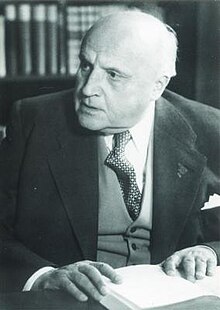Erhard Schmidt (mathematician)
Erhard Schmidt (born January 1 . Jul / 13. January 1876 greg. Today in Dorpat ( Tartu , Estonia ); † 6. December 1959 in Berlin ) was a German mathematician who mainly in functional analysis worked.
Life
Schmidt was the son of the professor of physiology in Dorpat Alexander Schmidt , who did important work on the explanation of blood coagulation. He studied after attending the high schools in Tartu and Riga first in Dorpat and then in Berlin mathematics at Hermann Schwarz and in Göttingen under David Hilbert , where he met with a thesis on integral equations in 1905 PhD ( development of arbitrary functions for systems prescribed ) was. Hilbert was in the middle of his program of developing the fundamentals of what is now called functional analysis, and Schmidt became one of his most important contributors. In 1906 he completed his habilitation in Bonn with Eduard Study and then went to Berlin, where he succeeded Schwarz in 1917, via positions as professor in Zurich (1908), Erlangen and Breslau . With Ludwig Bieberbach and Issai Schur , who were appointed soon after, and the chair for applied mathematics set up at Schmidt's instigation and occupied by Richard von Mises , Berlin was one of the centers of attraction for mathematics in Germany in the 1920s. 1929–1930 he was rector of the University of Berlin. But he was not only a good organizer, but a successful and inspiring teacher, as Heinz Hopf testifies, who heard him in 1917 in Breslau and later studied with him in Berlin. In 1950 he retired, but remained director of the Research Institute for Mathematics at the German Academy of Sciences in Berlin until 1958. He was one of the founders of two important German journals: Mathematische Zeitschrift (1918) and Mathematische Nachrichten (1948).
In 1927 and 1928 and again from 1935 to 1936 he was President of the German Mathematicians Association and in 1936 head of the German delegation to the International Congress of Mathematicians in Oslo . Since 1918 he was a member of the Prussian Academy of Sciences , in 1942 he was elected a corresponding member of the Bavarian Academy of Sciences . In 1956 he was accepted as a corresponding member of the Académie des sciences .
Schmidt is considered one of the founders of functional analysis, many of the concepts in the theory of Hilbert spaces, which arose from the investigation of integral equations in the Hilbert school, come from him. It considerably simplifies the representations made by Hilbert and Ivar Fredholm and also deals with nonlinear integral equations. The Gram-Schmidt orthonormalization method is known for developing an orthonormal system of eigenfunctions. In the Rendicondi di Circolo Math.di Palermo of 1908 he deals with the resolution of infinitely dimensional systems of equations from a wide variety of points of view. Schmidt could never get used to the reformulation of the theory in the hands of his student John von Neumann .
Schmidt also worked in analytical number theory, topology (new simple proof of the Jordanian curve theorem, session reports Preuss.Akad.Wiss. 1923) and most recently from 1939 on isoperimetric problems in geometry. In his early work, he also dealt with the definition of content terms and curve length in analysis.
He had been married to Berta von Bergmann since 1909, who died in 1916 giving birth to a third son.
literature
- Annette Vogt: Schmidt, Erhard . In: Who was who in the GDR? 5th edition. Volume 2. Ch. Links, Berlin 2010, ISBN 978-3-86153-561-4 .
Web links
- Literature by and about Erhard Schmidt in the catalog of the German National Library
- John J. O'Connor, Edmund F. Robertson : Erhard Schmidt (mathematician). In: MacTutor History of Mathematics archive .
- Erhard Schmidt in the Mathematics Genealogy Project (English)
- Schmidt: On the theory of linear and nonlinear integral equations. Part 1, Mathematische Annalen Bd.63 1907 , part 2 is here: [1] , part 3 from Mathem. Annalen Vol. 65, 1908, is here: [2]
- Dinghas: Erhard Schmidt. Annual report DMV 1970/1
- Hans Rohrbach: Erhard Schmidt to the memory. Annual report DMV 1967/8
- Schmidt's list of publications
- Biography of Karin Reich
Sources and footnotes
- ↑ Entry in the baptismal register of the university parish in Dorpat (Estonian: Tartu ülikooli kogudus)
- ^ List of members since 1666: Letter S. Académie des sciences, accessed on February 27, 2020 (French).
- ^ Mathematische Annalen Vol. 63, 1907. Also named after the Danish mathematician Jörgen Gram, but also known to Laplace.
| personal data | |
|---|---|
| SURNAME | Schmidt, Erhard |
| BRIEF DESCRIPTION | German mathematician and co-founder of modern abstract functional analysis |
| DATE OF BIRTH | January 13, 1876 |
| PLACE OF BIRTH | Dorpat (now Tartu ), Estonia |
| DATE OF DEATH | December 6, 1959 |
| Place of death | Berlin |
